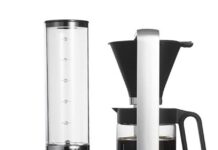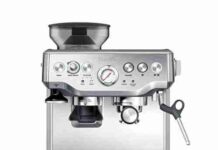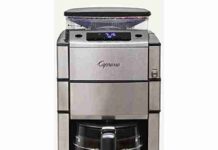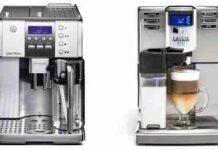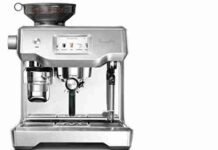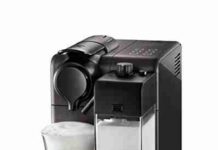Coffee lovers know that a freshly brewed cup of joe is the perfect way to kickstart the day. But did you know that maintaining and descaling your coffee machine is crucial for ensuring a consistently great-tasting brew? In this article, we explore the question that often plagues coffee enthusiasts: how often should you descale a coffee machine? We’ll uncover the factors that influence the frequency of descaling and provide useful tips to keep your coffee machine functioning at its best. So grab your favorite mug and get ready to discover the secrets to a perfectly brewed cup of coffee every time!
Importance of Descaling
Descaling is an essential maintenance task that all coffee machine owners should prioritize. It involves removing the mineral deposits that accumulate inside the machine over time. Neglecting this task can lead to various issues and compromise the quality of your coffee and the lifespan of the machine. In this article, we will discuss the importance of descaling and provide useful guidelines for determining how frequently it should be done.
Preventing Mineral Build-up
One of the primary reasons why descaling is important is to prevent mineral build-up in the coffee machine. Over time, minerals such as calcium and magnesium found in water can accumulate and form scales. These scales can clog the internal components of the machine, including pipes, valves, and heating elements. When these components are blocked, the machine’s performance is affected, resulting in poor brewing, slow brewing, or even complete breakdown.
Regular descaling helps to remove these mineral deposits and ensures that your coffee machine continues to function at its best. By preventing mineral build-up, you can maintain optimal coffee quality and prolong the lifespan of the machine.
Maintaining Optimal Coffee Quality
If you’re a coffee enthusiast like us, you understand the importance of a great-tasting cup of joe. Mineral build-up can significantly impact the taste and aroma of your coffee. When scales form inside the machine, they can alter the flavor profile by introducing unwanted minerals or impurities into your brew.
By regularly descaling your coffee machine, you can ensure that your coffee maintains its true and rich flavor. Descaling removes any residues or impurities that might affect the taste, allowing you to enjoy a delicious cup of coffee every time.
Prolonging the Lifespan of the Coffee Machine
Investing in a high-quality coffee machine is a significant investment. To maximize the lifespan and performance of your machine, it is crucial to establish a regular descaling routine. The accumulation of scales and mineral deposits can lead to the deterioration of internal components, which can ultimately cause the machine to break down.
By descaling your coffee machine at recommended intervals, you can prevent damage caused by mineral build-up, ultimately prolonging the lifespan of the machine. Regular maintenance, including descaling, will help keep your coffee machine in excellent condition for years to come.
Factors Affecting Descaling Frequency
Several factors influence the frequency at which you should descale your coffee machine. Understanding these factors will help you determine the appropriate descaling schedule for your specific situation.
Water Hardness
The hardness of the water you use plays a significant role in determining how frequently descaling is required. Hard water contains higher mineral concentrations, including calcium and magnesium. Consequently, coffee machines that are exposed to hard water may require more frequent descaling.
To assess the hardness of your water, you can perform a simple water hardness test or consult your local water authority for information on the water quality in your area. Based on the results, you can adjust your descaling frequency accordingly.
Usage Frequency
The frequency at which you use your coffee machine also affects descaling. If you use your coffee machine daily, the chances of mineral build-up will be higher compared to someone who uses it less frequently. Regular usage leads to more contact between water and internal components, increasing the likelihood of mineral deposits.
Considering your usage frequency will help you determine if more frequent descaling is necessary. If you use your coffee machine heavily, it may be advisable to descale more often to prevent the build-up of scales.
Coffee Machine Type
Different types of coffee machines have varying internal systems, which can impact the descaling requirements. Single boiler, dual boiler, and super-automatic coffee machines may have different susceptibility to mineral build-up.
It is essential to refer to your coffee machine’s user manual for specific descaling recommendations. Manufacturers usually provide guidelines tailored to their machine’s specifications, giving you clear instructions on the appropriate descaling frequency for your specific coffee machine.
General Descale Frequency Guidelines
While factors such as water hardness and usage frequency play a significant role in determining descaling frequency, there are general guidelines that can be followed. These guidelines provide a starting point and can be adjusted based on the specific considerations discussed earlier.
User Manual Recommendations
When it comes to descaling your coffee machine, the first point of reference should be the manufacturer’s recommendations outlined in the user manual. Manufacturers have extensive knowledge of their product and will provide detailed instructions on when and how to descale their specific coffee machine models.
Make it a habit to consult the user manual and follow the recommendations provided. This ensures you are adhering to the manufacturer’s guidelines, optimizing the performance and longevity of your coffee machine.
Water Hardness Test
Performing a water hardness test is an excellent way to determine your coffee machine’s descaling needs. Water hardness test kits are readily available and provide an accurate measure of the mineral content in your water.
By knowing the level of water hardness, you can make informed decisions regarding descaling frequency. If the water hardness is high, more frequent descaling might be required. Conversely, if the water hardness is low, descaling can be done less frequently.
Every 3-6 Months
As a general guideline, it is recommended to descale your coffee machine every 3-6 months. This timeline provides a balance between maintaining optimal coffee quality and preventing excessive mineral build-up.
Regular descaling at this frequency ensures that any potential scales or deposits are removed before they have a chance to adversely affect your coffee machine’s performance. However, it is essential to consider the specific factors mentioned earlier to customize the descaling schedule to your specific situation.
Water Hardness Test
Testing Water Hardness
To perform a water hardness test, you can use a water hardness test kit, readily available at most home improvement stores or online retailers. The kit usually contains test strips or tablets that you can use to measure water hardness.
Follow the instructions provided with the test kit to collect a water sample and test its hardness. Ensure that the water sample is representative of the water you use in your coffee machine.
Interpreting Results
The test results will indicate the level of water hardness based on a color-coded scale provided with the test kit. The scale typically ranges from soft to very hard water. Soft water indicates a low mineral content, while very hard water suggests a high concentration of minerals.
By comparing the color of the test strip or the result obtained with the scale, you can determine the hardness of your water accurately.
Adjusting Descale Frequency
Once you have determined the hardness of your water, you can adjust the descaling frequency accordingly. If the water is soft, descaling may be required less frequently, while hard water may necessitate more frequent descaling.
Remember to consider other factors, such as usage frequency and coffee machine type, to further fine-tune your descaling schedule. Customizing the descaling frequency ensures that your coffee machine remains in optimal condition and delivers outstanding coffee quality.
Specific Descale Frequency
Different types of coffee machines may have specific descaling requirements. Understanding the descale frequency for your particular coffee machine type will help you maintain its performance and longevity.
Single Boiler Coffee Machines
Single boiler coffee machines often have a lower descaling frequency compared to other types. As they have fewer internal components and contact points with water, the risk of mineral build-up is relatively lower.
In general, it is recommended to descale single boiler coffee machines every 4-6 months. However, it is crucial to refer to the manufacturer’s recommendations outlined in the user manual for precise instructions tailored to your specific machine.
Dual Boiler Coffee Machines
Dual boiler coffee machines have separate boilers for brewing and steaming. These machines typically require more frequent descaling due to the additional boiler and plumbing system involved.
For dual boiler coffee machines, it is advisable to descale every 3-4 months. Again, consult the manufacturer’s guidelines to ensure you adhere to their specific recommendations.
Super-Automatic Coffee Machines
Super-automatic coffee machines, with their integrated grinder and automatic brewing system, require regular descaling to maintain optimal performance. The complexity of these machines and the multitude of internal components make them more susceptible to mineral build-up.
To keep your super-automatic coffee machine in the best condition, descaling should be done every 2-3 months. As always, refer to the manufacturer’s instructions for precise guidelines on maintaining your specific super-automatic coffee machine.
Signs That Your Coffee Machine Needs Descaling
Even with general guidelines and specific descaling frequencies, it is essential to be aware of signs indicating that your coffee machine needs descaling. These signs can help you identify when it’s time to perform the descaling process.
Unpleasant Taste or Odor
If you notice a significant change in the taste or odor of your coffee, it may be an indication that your coffee machine needs descaling. The presence of mineral deposits in the internal components can alter the flavor profile and introduce unpleasant tastes or odors into your brew.
If your coffee starts tasting off or has an unusual smell, it’s time to descale your machine to restore its optimal performance and the true flavors of your favorite coffee beans.
Slow Brewing
A coffee machine that takes noticeably longer to brew your coffee could be a sign of mineral build-up. Scales and deposits can obstruct the flow of water through the machine, resulting in a slower brewing process. If you experience prolonged brewing times, it may be an indicator that descaling is needed.
Descaling will remove these obstructions, allowing for a consistent and efficient brewing process.
Scaling or Mineral Deposits
Visible scaling or mineral deposits on the internal components of your coffee machine is a clear indication that descaling is required. If you notice white or brownish build-up on your machine’s heating element, water tank, or pipes, it’s time to take action.
These deposits can hinder the proper functioning of the machine and lead to various performance issues. Descaling will eliminate these unsightly deposits and prevent further damage to your coffee machine.
Different Descaling Methods
When it comes to descaling your coffee machine, there are several methods you can choose from. Each method has its benefits and considerations, so it’s essential to select the one that works best for you.
Vinegar Solution
Using a vinegar solution is a common and cost-effective method for descaling coffee machines. Vinegar is an acid that can effectively dissolve mineral deposits, making it an excellent choice for descaling.
To descale using a vinegar solution, mix equal parts white vinegar and water. Fill your coffee machine’s water reservoir with the solution, then run a brewing cycle without any coffee grounds. Repeat the process using clean water to rinse the machine thoroughly.
It is important to note that the strong odor of vinegar may linger in your coffee machine after descaling, so a thorough rinsing is crucial to remove any residual taste or smell.
Citric Acid Solution
Citric acid is another effective descaling agent that can be used to remove mineral deposits from your coffee machine. It is readily available in powdered form and is known for its ability to dissolve scales and restore optimal performance.
To create a citric acid solution, mix a tablespoon of citric acid powder with a liter of water. Pour the solution into your coffee machine’s water reservoir and run a brewing cycle without coffee grounds. Just like with the vinegar solution, rinse the machine thoroughly with clean water afterward.
Citric acid is often favored as it produces less odor compared to vinegar and is generally safe to use on various coffee machine types.
Commercial Descalers
Commercial descaling products are specifically designed to remove mineral deposits from coffee machines. These descalers are available in liquid or tablet form, and they offer convenience and ease of use.
To use a commercial descaler, follow the instructions provided on the packaging. Typically, you will need to mix the descaling solution with water and run it through your coffee machine according to the manufacturer’s recommendations.
Commercial descalers are specifically formulated for coffee machines, ensuring safe and effective descaling without any potentially harmful residues. They are an excellent option for those who prefer a hassle-free descaling process.
Step-by-Step Descaling Process
Regardless of the descaling method you choose, the general descaling process involves several steps. Following these steps will help ensure a thorough and effective descaling of your coffee machine.
Prepare the Coffee Machine
Start by emptying and cleaning your coffee machine’s water reservoir. Remove any water filters or cartridges that may be present. If your machine has a detachable brew group, remove it as well for separate cleaning if required.
Prepare the Descaling Solution
Determine the appropriate descaling solution based on your chosen method. Whether it’s a vinegar solution, citric acid solution, or a commercial descaler, prepare the solution according to the instructions provided.
Pour the descaling solution into the water reservoir of your coffee machine. Ensure that the reservoir is filled with the appropriate amount of solution for effective descaling.
Run the Descaling Cycle
Switch on your coffee machine and initiate the descaling cycle. Follow the instructions in your user manual to activate the descaling program specific to your machine. Allow the machine to complete the cycle, ensuring that the descaling solution flows through all relevant components.
During the descaling cycle, the solution will dissolve and eliminate the mineral deposits, cleaning the internal components thoroughly. Take note of any additional steps or instructions provided by the manufacturer to get the best results.
After the descaling cycle is complete, thoroughly rinse the coffee machine by running multiple brewing cycles with clean water. This ensures that any remnants of the descaling solution are completely flushed out.
Additional Maintenance Tips
In addition to regular descaling, there are several other maintenance practices you can follow to keep your coffee machine in optimal condition.
Regular Cleaning Practices
Apart from descaling, it is essential to clean your coffee machine regularly. This includes cleaning the brew group, portafilter, and other removable parts after each use. Additionally, wiping the exterior surfaces and keeping the water reservoir and drip tray clean will help prevent the build-up of residues and maintain the machine’s appearance.
Follow the specific cleaning instructions provided by the manufacturer for your coffee machine model. Regular cleaning prevents unnecessary blockages, keeps your machine hygienic, and ensures consistently excellent coffee.
Replacement of Parts
Over time, some parts of your coffee machine may deteriorate or become worn out. It is vital to monitor the condition of components such as seals, gaskets, and filters. If any of these parts show signs of wear or damage, it is advisable to replace them promptly.
Replacing worn-out parts ensures that your coffee machine operates optimally, preventing any potential leaks, blockages, or breakdowns. Consult the manufacturer or an authorized service center for genuine replacement parts and proper installation guidance.
Proper Storage
If you plan to store your coffee machine for an extended period, it is crucial to prepare it appropriately. Thoroughly clean and descale the machine, removing all residues and potential sources of contamination. Ensure that all water is drained from the machine to prevent the growth of mold or bacteria.
Store your coffee machine in a cool, dry place, away from direct sunlight and extreme temperatures. Consider covering it with a dust cover or storing it in its original packaging to provide additional protection.
By following proper storage practices, you can maintain the integrity of your coffee machine and ensure it is ready for use when you decide to bring it back into service.
Conclusion
Regular descaling is a vital aspect of coffee machine maintenance that should not be overlooked. Descaling helps prevent mineral build-up, maintains coffee quality, and prolongs the lifespan of the machine. By considering factors such as water hardness, usage frequency, and coffee machine type, you can determine the appropriate descaling frequency for your specific situation.
Whether you choose to use a vinegar solution, citric acid solution, or commercial descaler, following the step-by-step descaling process ensures a thorough and effective cleaning. Additionally, incorporating regular cleaning practices, replacing worn-out parts, and proper storage will further enhance the performance and longevity of your coffee machine.
Investing time and effort into regular descaling and maintenance practices will result in consistent, high-quality coffee and a coffee machine that continues to serve you for years to come. So, let’s raise our cups and toast to the importance of descaling – a simple yet essential routine that keeps our coffee machines running smoothly and our spirits caffeinated!


